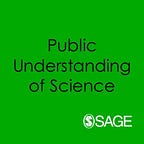The Ascent of John Tyndall: Victorian Scientist, Mountaineer and Public Intellectual
Review by Brian Trench
Tyndall was a public science communicator before the category had to be invented
When John Tyndall finally took up a long-standing invitation to do a lecture tour in the United States, he spoke to audiences of many hundreds in several major cities. There was a queue of 500 to get into his first Boston lecture, and an attendance of 1,200. President Grant attended one of his lectures in Washington. The New York Daily Tribune sold 300,000 copies of transcripts, at 30 cents each, of his lectures in that city — this series was run in both Manhattan and Brooklyn.
By this time, 1871–72, Tyndall was reaching very large audiences also with his books and articles. A collection of essays, Fragments of Science, was many times revised, re-issued and translated, likewise his books, Heat, Light and Sound. Heat had three editions in 1867 alone, and was published in France, Germany, Russia and Italy, among other countries. From the 1840s to the 1880s Tyndall was a frequent contributor to regional newspapers in Ireland and England, and to literary and commentary periodicals of many flavours.
Tyndall was a public science communicator before the category had to be invented. Indeed, he was a professional scientist before that occupation was fully formed. The two went hand-in-hand: as resident professor at the Royal Institution (RI) he was required to give public lectures. Succeeding Michael Faraday in this role, he developed further the reach of the RI’s (still existing) Christmas Lectures, which were attended by 700–800 people, including leading figures in the political and cultural elite, as well as others of the educated classes. But Tyndall also sought out opportunities to give talks to socially more diverse audiences, notably through working men’s institutes.
Tyndall was honoured as a scientist in his own lifetime, being offered several professorships that he declined, serving as a Fellow of the Royal Society and President of the British Association for the Advancement of Science, and receiving honorary degrees from Cambridge, Oxford and Trinity College Dublin. Yet, he has been the subject of only one full biography up to this one — and that was published in 1945. Roland Jackson seeks to fill the gap with a densely annotated work drawing on Tyndall’s journals and on the collated correspondence to and from Tyndall. The gains in detail and sourcing — the 2,000-plus notes cover more than sixty pages, and there are repeated lists of social engagements — are matched by losses in context and evaluation.
The use of the modern term, public intellectual, in the title is both an attraction and a frustration; the concept, as Tyndall embodied it, is hardly explored. The reader can admire — as the author very clearly does — the very many public roles Tyndall played, including, for example, on numerous technical, educational and other committees. But we are not given the means to assess how he compared in this regard with contemporaries (and friends), such as Carlyle, Huxley, Darwin and Pasteur.
Jackson makes some passing judgements and gives a short, summary assessment in an Epilogue. Here he suggests that the relative neglect of Tyndall may be partly due to his scientific discoveries being soon surpassed, even in his lifetime. However, the emergence of climate science has led to more recognition of Tyndall’s work on the absorption of heat by gases, the basis of understanding the greenhouse effect. Tyndall’s name is on a climate research centre in England and a nanotechnology research centre in Ireland. He is an iconic figure for the Irish science heritage movement, and even has a pub named after him in his native country.
Elsewhere — in Switzerland and the United States — Tyndall has mountain peaks named after him, a tribute to his pioneering role in mountaineering. Over many years, he spent two or more summer months in the Alps, undertaking hazardous climbs, but also conducting experiments and observations on atmosphere and glaciers. Jackson shares this interest with his subject, and gives this aspect of Tyndall’s life reverential attention.
But the biography moves carefully around personal and political assessments of Tyndall. He took conservative, even reactionary, positions on many issues and his intervention in the post-Darwin science wars may have been motivated as much by anti-Catholicism as a science-based critique of religion. It is clear he long had a predilection for girls and very young women but when he did marry in his frail fifties, he formed a loving and very productive partnership with Louisa Hamilton, his (never formally acknowledged) co-author on many works. She took responsibility for the mistake in administering his medicines that killed Tyndall, and outlived him guiltily for 47 years. She never completed the task of organizing his papers that might have facilitated earlier biographies. Jackson has now done the detailed work on which others can build.
Brian Trench is a science communication researcher and trainer, formerly senior lecturer at Dublin City University, Ireland. Among his recent publications is Little Country, Big Talk — science communication in Ireland (2017), co-edited with P. Murphy and D. Fahy. He is book reviews editor at Public Understanding of Science.
